The Regimental Badges
The Regimental Distinction of The Royal Sussex Regiment, as shown in the Army List, was “The White Roussillon Plume.” This plume was given to the old 35th Foot in recognition of its services at the Battle of Quebec, when it engaged and severely defeated the French Royal Roussillon Regiment of Infantry, who wore in their headgear the “Plumet blanc” of the French Army. The plume as it appeared in the badges, etc., of the Regiment was not a copy of the plume anciently worn by the Royal Roussillon Regiment, nor of that originally worn by the 35th Foot.
When the South African War Memorial, erected on the sea front at Brighton, was in course of design, the architect, Mr. (later Sir) J. W. Simpson, went to much pains to find out the exact form of the old plume, and the result of his investigations is shown in the plumes which serve as ornaments on either side of the shield upon which appears the Crest of the Regiment, high up in the front of the pedestal of the above-mentioned memorial. It will be seen that the plume there portrayed was much more like the plume borne by the Royal Scots Greys, and of the different Regiments of Foot Guards, rather than the species of ostrich plume which in varying degrees of timidity peeps out from behind the different crests and badges used by the Regiment.
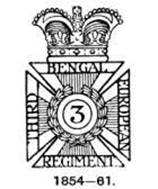
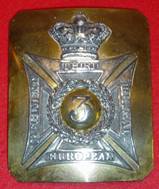
The badge worn by the 3rd Bengal European Regiment up to 1861.
On the right it is seen on the cross belt plate.
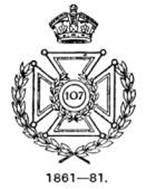
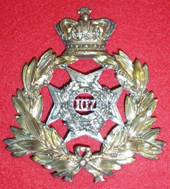
The badge worn by the 107th Foot up to 1881.
Shako & helmet plates, Glengarry & cap badges (Victorian)
In 1879 permission was granted for a badge consisting of the Garter Star with Roussillon plume to be worn on the officers’ forage caps. In different forms this badge was worn on the caps and collars of mess and service jackets by all Battalions of the Regiment except the 5th (Cinque Ports) Battalion, which retains its old badge, the Arms of the Cinque (pronounced sink) Ports.
The origin of the Garter in the Regimental Badge is, unfortunately, wrapped in mystery. Various explanations have been offered, but, as they are all founded on guess-work, no use would be served by going further into the matter, except to say that within living memory there has always been a tradition that the Garter Star is in some way associated with that Duke of Richmond who in the early years of the nineteenth century was Colonel of the 35th Foot, and who was a Knight of the Garter.
The right of the Royal Sussex Regiment to the use of the Garter Star in its badges has been questioned, unofficially, from time to time, but the fact remains that authority for the Star was definitely granted, at all events in 1879, as mentioned above, and that it duly appears in the authorized sealed pattern at the War Office.
At the same time it is a pity that an original grant of the Garter Star cannot be traced, and it can only be hoped that at some future time a record may turn up which will substantiate the claim of the Regiment to the right to wear it, dating back considerably further than 1879.
It may be noted here that the crests, etc., used did not give a correct rendering of the shape and shading of the “Garter Star.” The star given is correct for shading, but the shape of the Star is not quite right.
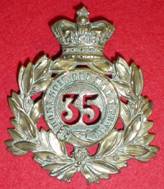
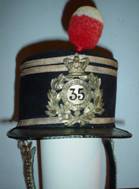
Other ranks’ shako plate 35th Foot pre 1878
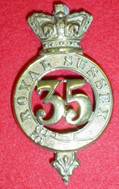
to 1881
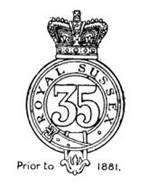
Glengarry Badge
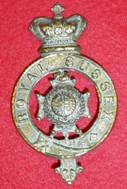
Post 1881
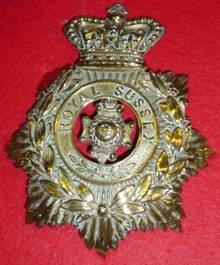
Other ranks’

Helmet plate Post 1881

Officers’
Note Kings Crown (post 1901) plate on Officer’s Helmet
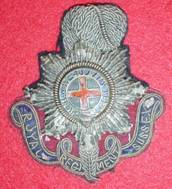
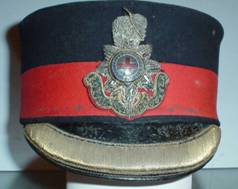
Officers’ bullion (cloth) forage cap badgepost 1881
The Cap Badges
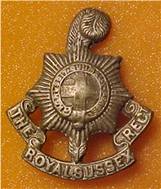
Other ranks’
WW1 economy brass

Bi-metal cap badge
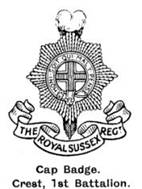

Officers’ cap badge


Other ranks’ cap badge


Officers’ cap badge
The Collar Badges
This was worn on the collars of full dress scarlet tunics, the old red serge jackets (which preceded khaki as drill order), and on blue serges. The same design appears on the officers’ buttons.
The badge consists of a Maltese Cross overlaying a Roussillon plume. On the centre of the cross is superimposed the central part of the Garter Star, i.e., St. George’s Cross surrounded by the Garter, and around this is added a wreath of laurels.
The Maltese Cross is an inheritance from the 3rd Bengal Europeans, to whom it was granted in 1854, and handed down by them to the 107th Foot. Contrary to popular report, there is no connection whatever between the Maltese Cross of the Regimental Badge and the fact that the 35th Foot took part in the Capture of Malta in 1800. The Maltese Cross was not borne in any shape or form by the 35th prior to the amalgamation of 1881.
The selection of a Maltese Cross as a badge for the 3rd Bengal Europeans appears to have been entirely fortuitous. Some badge had to be chosen, and it happened to be the Maltese Cross.
The form of the cross has been changed from time to time so far as its use as a Regimental Crest is concerned, the design shown above having been adopted in 1904 by the 2nd Battalion as its crest, and is still in use by that Battalion.
Incidentally it may be mentioned that the Maltese Cross in use in the badges, etc., of the Regiment has never, either officially or otherwise, conformed to the true pattern of the Maltese Cross as it is known in Malta. The true Maltese Cross has the arms much narrower and longer than any pattern used by the Regiment.








